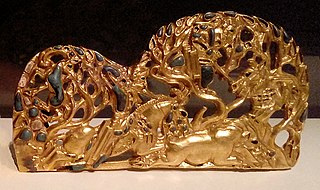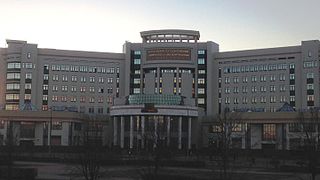
Kerch, also known as Keriç or Kerich, is a city of regional significance on the Kerch Peninsula in the east of Crimea. Kerch has a population of about 147,033 .

A kurgan is a type of tumulus constructed over a grave, often characterized by containing a single human body along with grave vessels, weapons and horses. Originally in use on the Pontic–Caspian steppe, kurgans spread into much of Central Asia and Eastern, Southeast, Western and Northern Europe during the 3rd millennium BC.

Turkology is a complex of humanities sciences studying languages, history, literature, folklore, culture, and ethnology of people speaking Turkic languages and Turkic peoples in chronological and comparative context. This includes ethnic groups from the Sakha in East Siberia to the Turks in the Balkans and the Gagauz in Moldova.

Askold and Dir, mentioned in both the Primary Chronicle, the Novgorod First Chronicle, and the Nikon Chronicle, were the earliest known rulers of Kiev.

Scytho-Siberian art is the art associated with the cultures of the Scytho-Siberian world, primarily consisting of decorative objects such as jewellery, produced by the nomadic tribes of the Eurasian Steppe, with the eastern edges of the region vaguely defined by ancient Greeks. The identities of the nomadic peoples of the steppes is often uncertain, and the term "Scythian" should often be taken loosely; the art of nomads much further east than the core Scythian territory exhibits close similarities as well as differences, and terms such as the "Scytho-Siberian world" are often used. Other Eurasian nomad peoples recognised by ancient writers, notably Herodotus, include the Massagetae, Sarmatians, and Saka, the last a name from Persian sources, while ancient Chinese sources speak of the Xiongnu or Hsiung-nu. Modern archaeologists recognise, among others, the Pazyryk, Tagar, and Aldy-Bel cultures, with the furthest east of all, the later Ordos culture a little west of Beijing. The art of these peoples is collectively known as steppes art.

Sergei Ivanovich Rudenko was a prominent Russian and Soviet anthropologist and archaeologist who discovered and excavated the most celebrated of Scythian burials, Pazyryk in Siberia.

Mikhail Illarionovich Artamonov was a Soviet and Russian historian and archeologist, who came to be recognized as the founding father of modern Khazar studies.

Mikhail Petrovich Pogodin was a Russian Imperial historian and journalist who, jointly with Nikolay Ustryalov, dominated the national historiography between the death of Nikolay Karamzin in 1826 and the rise of Sergey Solovyov in the 1850s. He is best remembered as a staunch proponent of the Normanist theory of Russian statehood.

Count Aleksey Sergeyevich Uvarov was a Russian archaeologist often considered to be the founder of the study of the prehistory of Russia.
Soviet historiography is the methodology of history studies by historians in the Soviet Union (USSR). In the USSR, the study of history was marked by restrictions imposed by the Communist Party of the Soviet Union (CPSU). Soviet historiography is itself the subject of modern studies.

Russian philosophy is a collective name for the philosophical heritage of Russian thinkers.
Rusʹ Khaganate, or kaganate of Rus is a name applied by some modern historians to a hypothetical polity suggested to have existed during a poorly documented period in the history of Eastern Europe between c. 830 and the 890s.

The Faculty of History is one of the faculties of the Moscow State University. Established at 1934 on the base of the Historical-philological faculty of the university. The dean of the faculty was Sergey Karpov.

Anti-Normanism is a movement of historical revisionism in opposition to the mainstream narrative of the Viking Age in Eastern Europe, and concerns the origin theory of Kievan Rus' that emerged in the 18th and 19th centuries. At the centre of the disagreement is the origin of the Varangian Rus', a people who travelled across and settled in Eastern Europe in the 8th and 9th centuries, and are considered by most modern historians to be of Scandinavian origin, but soon assimilated with the Slavs.
This page is based on this
Wikipedia article Text is available under the
CC BY-SA 4.0 license; additional terms may apply.
Images, videos and audio are available under their respective licenses.




















